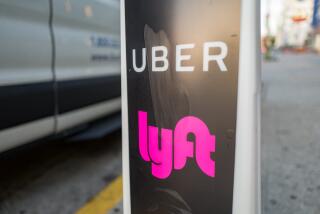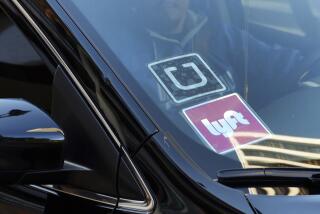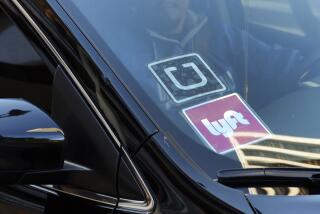Column: As was predicted, Uber’s IPO means you’ll be paying higher fares for your rides
Uber’s first-quarter earnings report released Thursday — its first since the ride-hailing company went public on May 10 — disclosed more than the financial condition of the company.
It also opened a window on the economic reality of the ride-hailing business. In discussing that reality, Uber executives revealed something that always percolated in the background about its business: Once Uber went public, its subsidized pricing would disappear.
That could create a new head wind for the company’s growth, which in any case has been slowing, according to the earnings release. As we’ve reported before, Uber’s success has been based on two unsustainable tactics: subsidizing fares and exploiting drivers.
We expect to deploy fewer consumer promotions in Q2 of 2019.
— Uber CFO Nelson Chai
During their conference call with investment analysts following the company’s earnings release Thursday, Uber’s leadership didn’t say explicitly that fares would be rising. But they gave a loud and clear signal. “We expect to deploy fewer consumer promotions in Q2 of 2019,” Chief Financial Officer Nelson Chai said. Translation: lower subsidies for riders.
Following that statement, Uber shares gained in trading after the stock market’s close. The bump-up carried over to Friday, with the shares gaining 70 cents, or 1.76%, to $40.50 in early trading on the New York Stock Exchange.
As for the company’s bottom line, it’s unhealthy. Uber reported a quarterly loss of $1.01 billion. Its “adjusted EBITDA,” an earnings metric it utilized during its private years, fell to a loss of $869 million, worse than the $817 million in the fourth quarter of 2018.
Chai’s promise and the trading pattern show that public investors will be taking a much harsher view of Uber’s marketing expenditures than did the private venture investors who have been providing the company with its capital up to now. This new reality applies to other ride-sharing companies, including Lyft, which went public a few weeks before Uber.
Let’s take a closer look at the structure of this business, as elucidated by the Uber disclosures. During the company’s private-market phase, its venture investors showered Uber with cash to fund what arguably was predatory pricing — Uber trips were priced at a discount to its traditional competition, taxis, to gain market share.
The harvest came in the form of unrelenting losses reaching more than $3 billion in 2018 alone. Investors were willing to swallow that red ink on the expectation that it would give the company a dominant position in its markets, allowing it eventually to set fares high enough to generate profits. They assumed that any losses they incurred would be made up in the IPO down the line.
Public investors aren’t nearly as patient or forgiving. They respond to results in the here and now. Unlike the venture investors, they don’t have an IPO as an exit strategy — they came in after the IPO. Moreover, unlike the venture gang, whose sentiment about the company can be hard to gauge, the public investors’ sentiment can be followed in real time via the stock price. Any CEO who ignores the electrocardiogram of stock trades for long is putting his career at risk.
The extent of Uber’s fare subsidy has been the topic of debate for years. Transportation industry expert Hubert Horan, writing at nakedcapitalism.com in 2016, calculated that riders were paying only 41% of the cost of their trips. He asked how Uber would keep their business if fares had to more than double to allow the company to break even.
“Uber’s growth to date is entirely explained by its willingness to engage in predatory competition funded by Silicon Valley billionaires pursuing industry dominance,” Horan observed.
Once that well ran dry, fares would rise, and one of Uber’s selling points — its price advantage compared with taxicab service — would narrow or disappear. Chai signaled on Thursday that the moment is now just over the horizon.
Uber’s earnings report suggests that it’s caught in a financial vise. Its gross bookings, which measure what customers spend, increased to $14.7 billion in the first quarter, a rise of 34%. But the growth was 37% in the fourth quarter and 41% a year earlier.
Yet Chai attributed the rise to “increased consumer promotions as well as increased advertising and marketing head count.” By stating that the promotional spending would ebb, he implicitly raised the question of how that would affect overall revenue. The smart money would say that the impact won’t be positive.
Keep up to date with Michael Hiltzik. Follow @hiltzikm on Twitter, see his Facebook page, or email michael.hiltzik@latimes.com.
Return to Michael Hiltzik’s blog.







